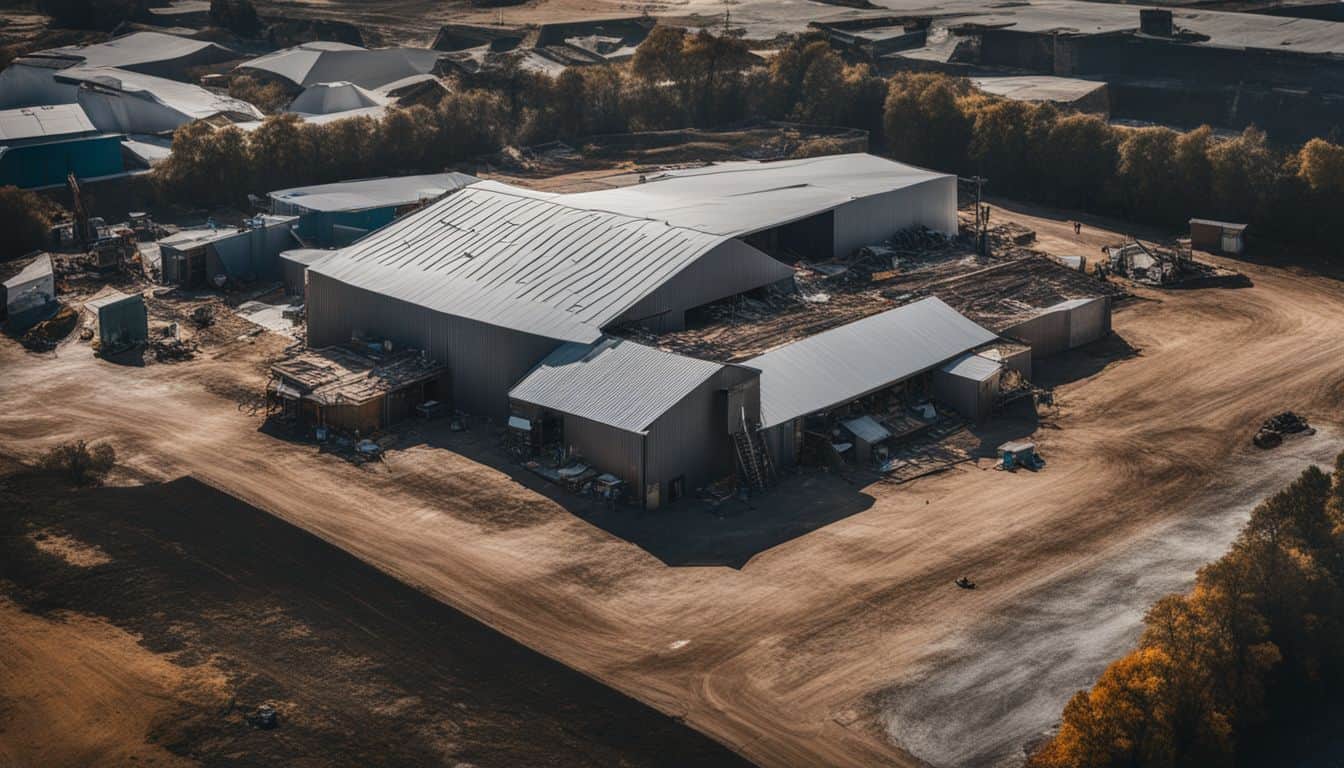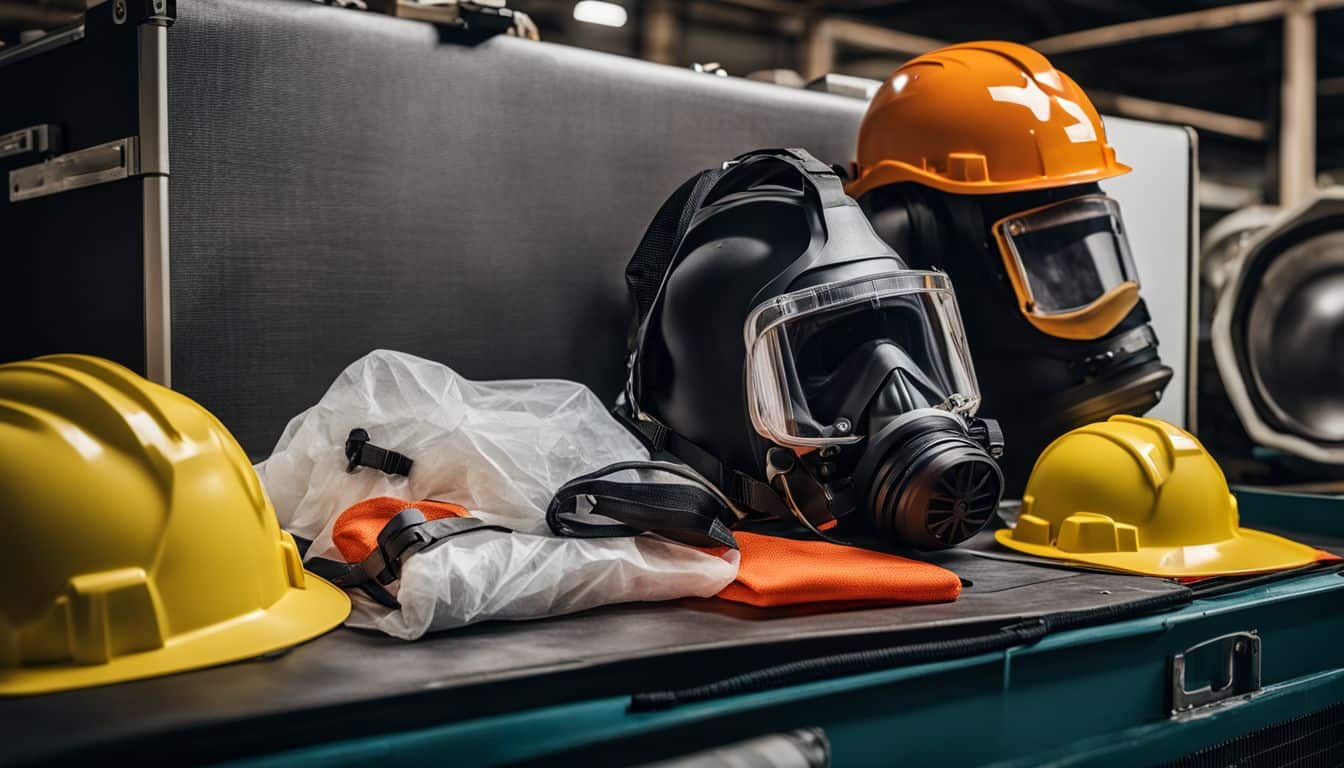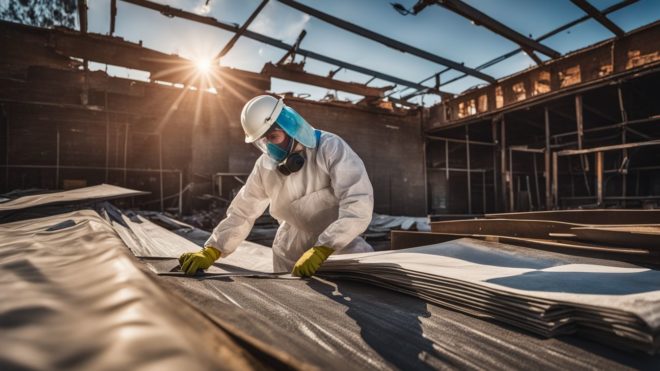Getting rid of asbestos roof panels is a challenge many homeowners face. Asbestos was banned in the UK in 1999, highlighting its danger. This article provides steps to safely remove and dispose of these harmful building parts.
Keep reading for essential tips.
Key Takeaways
- Before removing asbestos roof sheets, always wear protective clothing and a high – quality face mask to avoid inhaling dangerous fibres.
- It’s essential to keep asbestos materials wet during removal to prevent harmful particles from becoming airborne, protecting both workers and the environment.
- Use hand tools instead of power tools when removing asbestos sheets because they reduce the risk of releasing fibres into the air.
- Proper disposal involves placing asbestos waste in specialised bags designed for hazardous materials before contacting local council services or hiring professional removal contractors for safe handling.
- Opting for professional removal services ensures compliance with safety regulations and reduces health risks associated with improper disposal methods.
Identifying Asbestos in Roof Sheets

Identifying asbestos in roof sheets requires a keen eye and knowledge about building materials used before 2000. Given that asbestos was banned in the UK in 1999, homes constructed prior might still contain this hazardous substance.
Roof sheets made of reinforced plastic or certain fibres during this era often included asbestos for its insulation and fire-resistant qualities. One key sign of asbestos presence is a corrugated pattern commonly found in older roofing materials.
Additionally, these sheets usually have a distinct, slightly greyish colour compared to purely cement or newer synthetic alternatives.
To confirm the presence of asbestos beyond visual inspection, it’s wise to consult an experienced specialist who can conduct thorough testing. These professionals use specific hardware designed to safely identify asbestos-containing materials without releasing harmful fibres into the air.
Such steps ensure health & safety guidelines are followed, reducing risks associated with inhaling asbestos dust which poses serious health hazards.
Moving on, let’s discuss essential safety precautions necessary for handling and removing these dangerous materials effectively.
Safety Precautions for Asbestos Removal

Handling asbestos needs great care. Wear safety gear and dampen sheets to keep fibres from flying.
Use of Protective Clothing and Face Masks
Wearing the right protective clothing and face masks is critical during asbestos disposal. This gear protects you from inhaling harmful fibres that can cause serious health issues.
Experts always recommend full-body suits, gloves, and high-quality respirators for anyone involved in asbestos removal. These items form a barrier against the tiny particles, ensuring your safety.
Ensuring all protective items fit well is crucial. Loose-fitting masks or torn suits offer little protection against asbestos exposure. Always check for defects before starting work and replace any damaged equipment immediately.
This approach keeps you safe while handling hazardous materials.
“Safety isn’t expensive, it’s priceless.”
Moistening Panels to Prevent Airborne Fibres
After putting on protective gear and face coverings, the next crucial step is moistening panels. This method helps trap harmful fibres that can become airborne during the removal process.
Wetting down asbestos sheets prevents these dangerous particles from escaping into the air, thereby protecting workers and the surrounding environment from potential health risks.
To effectively reduce fibre release, it’s essential to evenly dampen the asbestos sheets before any removal begins. Using a low-pressure water spray or a wetting agent ensures an even spread of moisture across all surfaces.
This key action not only adheres to health and safety guidelines but also aligns with recommendations by industry experts such as A-Z Waste Recyclers for safely managing waste material.
Process of Asbestos Roof Sheet Removal
Removing asbestos roof sheets demands a careful approach to ensure safety. First, workers must select the right tools like ladders and protective gear to prevent direct contact with asbestos.
They then proceed to detach each sheet with precision, avoiding any action that could break them and release harmful fibres into the air. This task requires both patience and attention to detail from start to finish.
Using Appropriate Tools
Selecting the right equipment is essential for safely removing asbestos roof sheets. Use hand tools instead of power tools to cut or drill into the material, as this prevents the release of harmful asbestos fibres into the air.
It’s crucial to have a garden sprayer or a similar device on hand to keep the asbestos wet during removal, which significantly reduces dust.
Next, ensure you carefully remove screws or bolts from the sheets using appropriate screwdrivers or spanners, avoiding any breakage. This careful handling keeps everyone safe and makes disposal easier.
“A stitch in time saves nine.”
Prepare for careful handling and secure disposal as we move onto how best to dispose of asbestos materials safely.
Careful Handling to Avoid Breakage
After choosing the right tools, it’s essential to focus on careful handling of asbestos roof sheets. These materials can easily break if mishandled, releasing harmful fibres into the air.
Wear gloves and keep your movements steady and deliberate when lifting or moving them. Ensure each sheet remains intact as much as possible to minimise exposure to asbestos.
Placing asbestos sheets gently onto a flat surface will reduce their chance of cracking. Use teamwork whenever feasible; having one person support the weight at each end spreads out the stress and lessens the risk of damage.
This approach protects you from the dangers of airborne fibres that could harm your health if inhaled.
Disposal of Asbestos Roof Sheets
Disposing of asbestos roof sheets needs careful handling and specific disposal methods to ensure safety. You must place the sheets in specialist hazardous material bags, contact your local council for collection services, or hire professionals skilled in safe disposal practices.
Using Specialist Asbestos Bags
For safe disposal of asbestos roof sheets, professionals often recommend using specialist asbestos bags. These sturdy containers are made to hold and safely manage asbestos materials during the removal process.
Their design meets regulatory standards for containing and disposing of hazardous waste, ensuring that people handle these dangerous materials correctly.
Packing the roofing material into these bags minimises exposure risk during disposal. It’s critical to follow the proper steps for enclosing asbestos in these special bags to guarantee safe handling.
This approach not only keeps you compliant with health rules but also safeguards everyone involved from potential harm caused by asbestos fibres.
Utilising Local Council’s Asbestos Collection Services
Local councils offer collection services for hazardous materials like asbestos, often at a lower cost than hiring private companies. This service provides an affordable way to get rid of asbestos roof sheets safely.
Different councils have varying rules on how much they’ll collect and when, so it’s key to check with yours for details.
If you decide to use your council’s service, remember there might be a wait time before they can pick up the waste. While dropping off asbestos at local disposal sites is free for residents, using this collection option may involve fees depending on your area.
These costs are generally less expensive thanks to subsidies provided by local authorities, making it a smart choice financially.
Considering Professional Asbestos Removal Contractors
After exploring how local councils can aid in the disposal of asbestos, it’s vital to consider hiring professional removal experts for those dealing with larger or more hazardous projects.
These specialists bring not only speed but also a higher level of safety to the process. They come equipped with special gear and have received training that enables them to handle dangerous materials safely.
Their expertise ensures that all asbestos waste is disposed of following strict regulations, which helps protect you and your community from potential health risks.
Opting for professionals who are members of the Asbestos Removal Contractors Association guarantees that you’re working with teams committed to high standards of practice and compliance.
While enlisting their services may come at a higher cost, such as £50 per sealed bag or £200 for disposing of larger items like domestic water tanks, this investment ensures safe and legal removal.
Getting help from accredited contractors mitigates the risk involved in handling harmful substances and offers peace of mind knowing that your project adheres to all necessary safety guidelines.
Conclusion
Removing asbestos roof sheets is a task that requires careful planning and execution. Specialist bags and local council services offer safe disposal options, while professional contractors can handle the job efficiently.
Ensuring safety through protective clothing and using the right tools are key steps in this process. Taking these actions helps manage the risks associated with asbestos, making buildings safer for everyone involved.
For more information on responsibly disposing of other items, such as mattresses, please visit how to properly dispose of your mattress.
FAQs
[Article 3 Title]: Disposing of Asbestos Roof Sheets
1. Can I remove asbestos roof sheets by myself?
It’s safer to hire professionals trained in handling and disposing of asbestos.
2. Where can I dispose of asbestos roof sheets?
You must take them to a designated landfill site that accepts hazardous materials like asbestos.
3. How should I transport asbestos roof sheets for disposal?
Securely wrap the sheets in heavy-duty plastic sheeting and label them as hazardous material before transporting.
4. What protective gear do I need if handling asbestos roof sheets?
Wear a high-quality respirator, gloves, and disposable overalls to protect yourself from asbestos fibres.
5. Is there a fee for disposing of asbestos materials?
Yes, most landfill sites charge a fee based on the weight or type of the hazardous material being disposed of.


